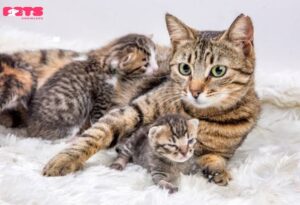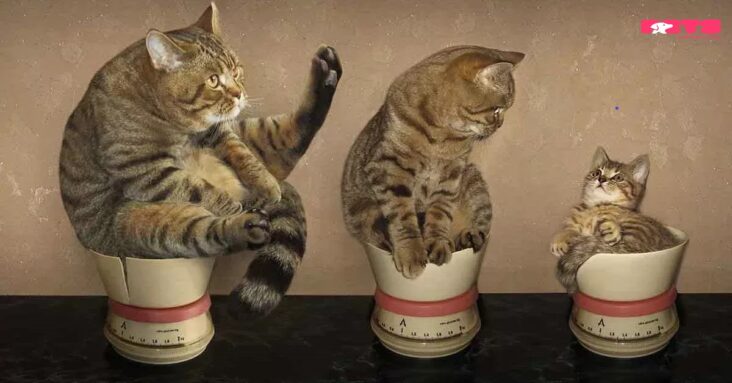Time is fleeting: before you look back, the kitten turns from a charming fluffy cat into a mature, handsome cat. Let’s find out When cats stop growing and what stages of development are associated with this.
What determines a cat’s growth?
Typically, a cat’s growth is completed between one and three years of age. Various external and internal factors influence this.
External factors affecting cat growth
External factors include, in particular, the conditions under which the pet is kept. The more favorable they are, the better the cat grows and develops. Street animals are usually smaller than domestic animals.
The cat must receive balanced, high-quality nutrition – this is one of the most important conditions for its growth.
Try to ensure that your pet avoids stress – it harms its health, just like chronic diseases and parasites. If an infection with insects or worms does occur, purchase special products for treating the cat.
It is also important to spay or neuter the animal on time. If surgery is performed on a pet after 1 year of age, it can significantly increase in size.
Internal Factors Affecting When Do Cats Stop Growing
Internal factors affecting cat growth include heredity, with larger parents generally having larger kittens. Gender also plays a role, as females are typically smaller than males. Female cats stop growing around 1.5 years old, while males continue to grow until 2-3 years old. Different cat breeds have varying growth patterns, with some breeds maturing by the age of five. Owners need to be aware of deviations from the normal growth trajectory, as they can impact a kitten’s size and health.
Deviations from the norm
In the first months of a kitten’s life, you may miss subtle deviations from the norm, but in the future, this will affect its size and even health. Therefore, a caring owner should know what factors can lead to the slow growth of a kitten.
Lack of milk
If a cat has given birth to many kittens, then some of them may lack milk. Weaker and smaller kittens need to be helped by placing them closer to the mother cat’s chest.
Genetic diseases
Congenital anomalies affect the growth and development of kittens. In this case, it is best to consult a veterinarian.
Endocrine problems
If the cat does not receive all the vitamins and microelements with food, then the kittens will not receive enough of them. That’s why it’s so important to choose special food for a mother cat for example, Hill’s Science Plan wet food for kittens is also suitable for nursing mothers.
Growing up as a cat by month

In the first year of life, the kitten’s maturation can be tracked by weeks and months. This period is divided into several stages.
Neonatal, or infancy, is the first 3-4 days of life. The weight of kittens changes and may even decrease, which is considered normal.
Lactation, when the kittens are breastfed, is 3–4 weeks. Stable growth and weight gain occur. All kittens in the litter must receive enough nutrition.
Transitional – approximately from the fourth to the eighth week after birth. The size of the kitten changes more slowly, almost imperceptibly.
Juvenile, or teenage, is a period from two months to a year. At this time, noticeable growth and formation of an adult occurs.
The most noticeable growth of kittens occurs between the ages of two months and six months. After this, most cats almost stop growing and only gain weight, and cats can become larger by a maximum of a couple of centimeters.
What diseases negatively affect a cat’s growth?
Some diseases affect a pet’s growth rate. For example, hormonal imbalance, diabetes mellitus, which slows down the growth of the cat, or viral infections. If you notice that your cat is not eating well and has lost weight, contact your veterinarian.
Useful tips for owners
The task of a responsible owner is to provide the pet with proper maintenance for healthy, timely growth.
The room in which the cat is kept, its bed, and bowls should always be clean. Do not forget to ventilate the room promptly.
Once every three months, carry out prevention against worms and also treat your cat regularly for fleas and ear mites.
Give your pet a comprehensive vaccination every year. This is necessary even for animals that do not leave the apartment.
Do not mate your pet too early to avoid causing hormonal imbalance.
Take care of your cat, give it as much attention as possible, buy high-quality diets for your pet, and you will not encounter problems with your pet’s growth. You can buy the following food at the Old Farm.
FAQs
- What external factors influence a cat’s growth?
External factors include the conditions under which the cat is kept, its nutrition, stress levels, and health status. Domestic cats generally grow larger than street cats due to better living conditions.
- How does nutrition impact a cat’s growth?
Balanced, high-quality nutrition is crucial for a cat’s growth. A proper diet ensures that the cat receives essential vitamins and minerals necessary for healthy development.
- Can stress affect a cat’s growth?
Yes, stress negatively impacts a cat’s health and growth. It’s important to provide a calm and stable environment for your cat.
- How do internal factors like heredity affect a cat’s growth?
Heredity plays a significant role in a cat’s growth. Large parents often have large kittens. Additionally, male cats generally grow larger than females and continue growing longer.

